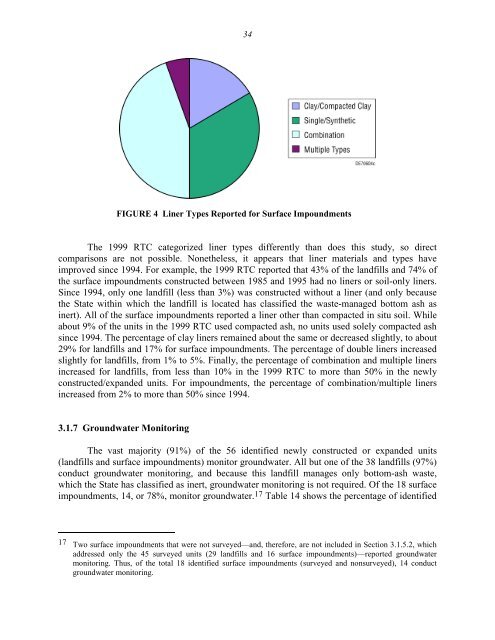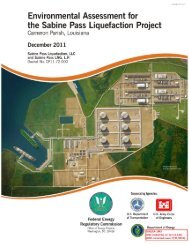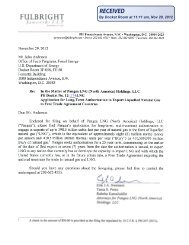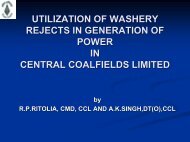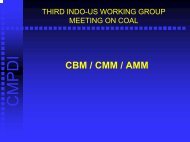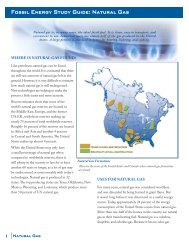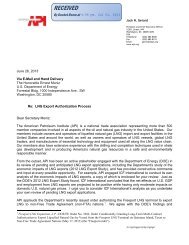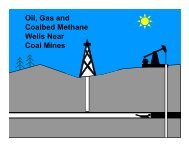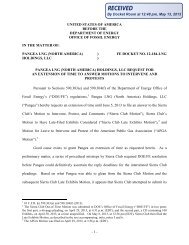- Page 5:
ACKNOWLEDGMENTS The authors wish to
- Page 8 and 9:
CONTENTS (Cont.) 3.1.9 Testing for
- Page 10 and 11:
TABLES (Cont.) 7 Trends in Construc
- Page 12 and 13:
TABLES (Cont.) A.14 Chronological C
- Page 14 and 15: xii
- Page 16 and 17: MCL maximum contaminant level MoDNR
- Page 18 and 19: xvi
- Page 20 and 21: S-2 the National Rural Electric Coo
- Page 22 and 23: S-4 Groundwater-monitoring requirem
- Page 24 and 25: S-6 receives only material that the
- Page 26 and 27: TABLE S-2 Summary Results from Chro
- Page 28 and 29: S-10 − In the area of groundwater
- Page 30 and 31: S-12
- Page 32 and 33: 2 Air heater and precipitator wash
- Page 34 and 35: 4 wastes, and 17% were bottom ash.
- Page 36 and 37: TABLE 1 (Cont.) State a Total CCWs
- Page 38 and 39: 8 The remainder of this report cont
- Page 40 and 41: 10 (NRECA) and the American Public
- Page 42 and 43: 12 Information collected during the
- Page 44 and 45: 14 − Type of variance (e.g., clos
- Page 46 and 47: 16 potential duplication with the s
- Page 48 and 49: TABLE 2 (Cont.) ID a Unit Name 18 S
- Page 50 and 51: 20 Because new power plants built d
- Page 52 and 53: 22 the number of new and expanded u
- Page 54 and 55: 24 TABLE 7 Trends in Construction C
- Page 56 and 57: 26 TABLE 8 Percentages of Wastes Di
- Page 58 and 59: 28 TABLE 9 Numbers and Types of Per
- Page 60 and 61: TABLE 11 Liner and Groundwater-Moni
- Page 62 and 63: FIGURE 2 Liners in Identified New o
- Page 66 and 67: 36 Constituents monitored. Landfill
- Page 68 and 69: 38 impoundments). The analysis does
- Page 70 and 71: 40 (Class I) wastes for which no li
- Page 72 and 73: 42 States (Alabama, Florida, Georgi
- Page 74 and 75: 44 TABLE 20 Solid Waste Permitting
- Page 76 and 77: 46 United States in 2004. The one S
- Page 78 and 79: 3.2.2 Findings 48 Table 22 summariz
- Page 80 and 81: TABLE 22 (Cont.) Category of Regula
- Page 82 and 83: 52 the surveyed units was conducted
- Page 84 and 85: TABLE 23 Variance Requests and Disp
- Page 86 and 87: 56 request, the State regulatory ag
- Page 88 and 89: TABLE 26 Variance Requests by Surve
- Page 90 and 91: TABLE 27 (Cont.) Variance Request S
- Page 92 and 93: 62 variance. However, the State (Vi
- Page 94 and 95: TABLE 28 (Cont.) Variance Request S
- Page 96 and 97: TABLE 29 Variance Requests by Surve
- Page 99 and 100: 69 5 REFERENCES ACAA 2004 American
- Page 101 and 102: A-1 APPENDIX A: STATE-SPECIFIC REGU
- Page 103 and 104: A.1 APPROACH A-3 APPENDIX A: STATE-
- Page 105 and 106: A-5 For each State reviewed, an eff
- Page 107 and 108: TABLE A.2 Summary of Regulatory Des
- Page 109 and 110: A-9 addition, the regulations in Al
- Page 111 and 112: TABLE A.3 Chronological Comparison
- Page 113 and 114: A-13 A disposal facility in Indiana
- Page 115 and 116:
TABLE A.4 Permits Required for CCW
- Page 117 and 118:
TABLE A.4 (Cont.) a The pilot study
- Page 119 and 120:
A-19 landfills. Otherwise, surface
- Page 121 and 122:
TABLE A.5 (Cont.) a “On-site” m
- Page 123 and 124:
A-23 groundwater and surface water
- Page 125 and 126:
A-25 discharge), the facility may s
- Page 127 and 128:
A-27 Wisconsin—Wisconsin designat
- Page 129 and 130:
TABLE A.6 (Cont.) State a Illinois
- Page 131 and 132:
TABLE A.6 (Cont.) State a Landfills
- Page 133 and 134:
TABLE A.6 (Cont.) State a Landfills
- Page 135 and 136:
TABLE A.7 Chronological Comparison
- Page 137 and 138:
TABLE A.7 (Cont.) State EPA 1988 EP
- Page 139 and 140:
A-39 Illinois—In Illinois, landfi
- Page 141 and 142:
A-41 The design standards for utili
- Page 143 and 144:
A-43 According to Technical Guideli
- Page 145 and 146:
TABLE A.13 Summary of Groundwater-M
- Page 147 and 148:
TABLE A.13 (Cont.) State a Groundwa
- Page 149 and 150:
A-49 such as a commercial industria
- Page 151 and 152:
A-51 The Indiana regulations do not
- Page 153 and 154:
A-53 developed guidance documents,
- Page 155 and 156:
A-55 groundwater. Table A.15 summar
- Page 157 and 158:
TABLE A.15 (Cont.) State Leachate-C
- Page 159 and 160:
A-59 TABLE A.16 Chronological Compa
- Page 161 and 162:
A-61 quality standards, or otherwis
- Page 163 and 164:
A-63 A.7 CLOSURE/POST-CLOSURE REQUI
- Page 165 and 166:
TABLE A.17 (Cont.) State Closure/Po
- Page 167 and 168:
A-67 Type III restricted waste site
- Page 169 and 170:
TABLE A.19 Summary of Corrective Ac
- Page 171 and 172:
A-71 the plume (329 IAC 10-29-9). T
- Page 173 and 174:
TABLE A.20 Summary of Siting Contro
- Page 175 and 176:
A-75 TABLE A.21 Chronological Compa
- Page 177 and 178:
A-77 The Virginia regulations speci
- Page 179 and 180:
A-79 TABLE A.23 Chronological Compa
- Page 181 and 182:
TABLE A.24 Summary of Additional In
- Page 183 and 184:
A.12 FINDINGS A-83 Table A.26 summa
- Page 185 and 186:
TABLE A.26 (Cont.) States with Chan
- Page 187 and 188:
TABLE A.26 (Cont.) Description of C
- Page 189 and 190:
A-89 TABLE A.27 Summary of States w
- Page 191 and 192:
B-1 APPENDIX B: QUESTIONNAIRE FOR N
- Page 193 and 194:
B-3 APPENDIX B: QUESTIONNAIRE FOR N
- Page 195 and 196:
Compacted ash Compacted in-situ soi
- Page 197 and 198:
7.0 Monitoring B-7 7.1 Is groundwat
- Page 199 and 200:
C-1 APPENDIX C: SURVEY RESPONSE RAT
- Page 201 and 202:
C-3 APPENDIX C: SURVEY RESPONSE RAT
- Page 203 and 204:
C-5 USWAG asked for a response from
- Page 205 and 206:
C-7 nonsurveyed units). The capacit
- Page 207 and 208:
D-1 APPENDIX D: RECONCILIATION OF U
- Page 209 and 210:
TABLE D.1 Reconciliation of Units I
- Page 211 and 212:
E-1 APPENDIX E: UNIT COMPLETION DAT
- Page 213 and 214:
TABLE E.1 Trends in Unit Completion
- Page 215 and 216:
F-1 APPENDIX F: MATERIALS DISPOSED
- Page 217 and 218:
TABLE F.1 Materials Disposed of at
- Page 219 and 220:
TABLE F.1 (Cont.) Coal Bottom Ash (
- Page 221 and 222:
TABLE F.1 (Cont.) Coal Other Unit C
- Page 223 and 224:
G-1 APPENDIX G: PERMITS ISSUED FOR
- Page 225 and 226:
TABLE G.1 Permits Issued for Survey
- Page 227 and 228:
TABLE G.1 (Cont.) Unit ID State Typ
- Page 229 and 230:
H-1 APPENDIX H: LINER DATA
- Page 231 and 232:
TABLE H.1 Liner Data Unit Is Unit N
- Page 233 and 234:
TABLE H.1 (Cont.) Unit Is Unit New
- Page 235 and 236:
TABLE H.1 (Cont.) Unit Is Unit New
- Page 237 and 238:
I-1 APPENDIX I: GROUNDWATER-MONITOR
- Page 239 and 240:
TABLE I.1 Groundwater-Monitoring Da
- Page 241 and 242:
TABLE I.1 (Cont.) ID GWM Conducted
- Page 243 and 244:
TABLE I.1 (Cont.) ID GWM Conducted
- Page 245 and 246:
TABLE I.1 (Cont.) ID GWM Conducted
- Page 247 and 248:
J-1 APPENDIX J: VARIANCE REQUESTS B
- Page 249 and 250:
TABLE J.1 Variance Requests by Stat
- Page 251 and 252:
K-1 APPENDIX K: VARIANCE REQUEST DE
- Page 253 and 254:
TABLE K.1 Variance Request Descript
- Page 255 and 256:
TABLE K.1 (Cont.) Variance Variance
- Page 257 and 258:
TABLE K.1 (Cont.) Variance Variance
- Page 259 and 260:
TABLE K.1 (Cont.) Variance Variance
- Page 261 and 262:
TABLE K.1 (Cont.) Variance Variance
- Page 263 and 264:
TABLE K.1 (Cont.) ID State Granted
- Page 265 and 266:
L-1 APPENDIX L: VARIANCE GRANTING R
- Page 267 and 268:
TABLE L.1 Variance Granting Rationa
- Page 269 and 270:
TABLE L.1 (Cont.) ID State Variance
- Page 271 and 272:
TABLE L.1 (Cont.) ID State Variance
- Page 273 and 274:
TABLE L.1 (Cont.) ID State Variance
- Page 275 and 276:
TABLE L.1 (Cont.) ID State Variance
- Page 277 and 278:
TABLE L.1 (Cont.) ID State Variance
- Page 279 and 280:
TABLE L.1 (Cont.) ID State Variance
- Page 281 and 282:
TABLE L.1 (Cont.) ID State Variance
- Page 283 and 284:
TABLE L.1 (Cont.) ID State Variance
- Page 285 and 286:
TABLE L.1 (Cont.) ID State Variance


